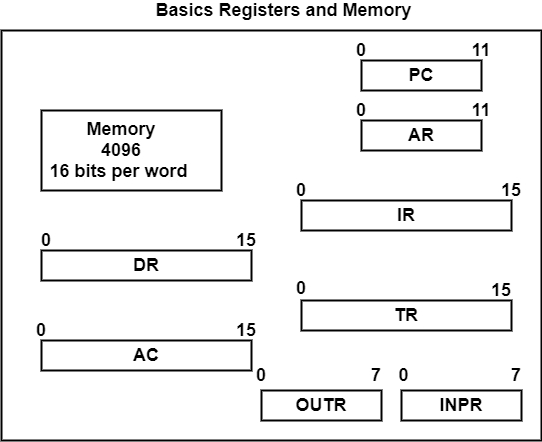What Does A Register Do
What are Figurer Registers in Computer Architecture?
Calculator registers are high-speed memory storing units. It is an chemical element of the computer processor. It tin conduct any type of information including a fleck sequence or single data.
A register should exist 32 $.25 in length for a 32-chip instruction computer. Registers can be numbered relies upon the processor design and language rules.
The instructions in a computer are saved in memory locations and implemented one afterward another at a time. The function of the command unit is to fetch the instruction from the retentiveness and implement information technology. The control does the similar for all the instructions in the memory in sequential order.
A counter is needed to maintain a path of the next didactics to be implemented and evaluate its address. The effigy shows the registers with their memories. The memory addresses are saved in multiple registers. These requirements certainly state the utilise for registers in a computer.

The following table shows the registers and their functions.
| Register Symbol | Number of Bits | Register Name | Function |
|---|---|---|---|
| OUTR | 8 | Output register | OIt holds output character. |
| INPR | 8 | Input annals | It holds input grapheme. |
| PC | 12 | Programme Counter | It holds the address of the instruction. |
| AR | 12 | Accost Annals | It holds an accost for memory. |
| DR | 16 | Data Annals | It holds memory operand. |
| Air-conditioning | 16 | Accumulator | It's a processor register. |
| IR | 16 | Education Register | It holds an instruction code. |
| TR | xvi | Temporary Annals | Information technology holds temporary information. |
The description for each of the registers determined in the figure is as follows −
- The information register holds the operand read from the retention.
- The accumulator is a full general-purpose register demand for processing.
- The pedagogy register holds the read memory.
- The temporary data used while processing is stored in the temporary annals.
- The address register holds the address of the instruction that is to be implemented adjacent from the retentiveness.
- The Program Counter (PC) controls the sequence of instructions to be read. In case a branch pedagogy is detected, the sequential execution does not arise. A branch execution calls for a transfer to an instruction that is not in sequence with the instructions in the PC.
- The input register (INPR) and output annals (OUTPR) are the registers used for the I/O operations. The INPR receives an eight-bit character from the input device. Information technology is similar to the OUTPR.

Published on 24-Jul-2021 09:20:17
- Related Questions & Answers
- What are Instruction Cycles in computer compages?
- What is computer architecture?
- What are Logic Micro-Operations in Estimator Architecture?
- What are snoopy cache protocols in computer architecture?
- What is Figurer Network Compages?
- Computer Organisation Architecture
- What are the types of Parallelism in Computer Compages?
- What are Instruction Codes and Operands in Computer Architecture?
- What are the types of Instructions in Computer Compages?
- What are the conditions of Parallelism in Computer Architecture?
- What are Vector-Access Memory Schemes in Computer Compages?
- What are the Data Routing Functions in Computer Architecture?
- What are the routing potential problems in Calculator Architecture?
- What are different levels of abstraction in Reckoner Architecture?
- What are semiconductor-based ROM memories in computer architecture?
Source: https://www.tutorialspoint.com/what-are-computer-registers-in-computer-architecture
Posted by: samswortatuslege.blogspot.com


0 Response to "What Does A Register Do"
Post a Comment